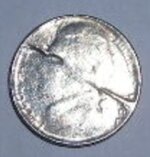mountainman 2
Bronze Member
- Aug 9, 2006
- 1,927
- 783
- Detector(s) used
- whites classic sl,whites surfmaster,garrett ATX,minelab vanquish 540
- Primary Interest:
- All Treasure Hunting
Found this nickel out of a MWR today. I've found a cud or two but this looks like something else. Looks like it has a big die crack right thru the center and no detail at all. The reverse is normal. Anyone know what this is called and how it's caused? Thanks for reading and looking, MM2
Attachments
Upvote
0







